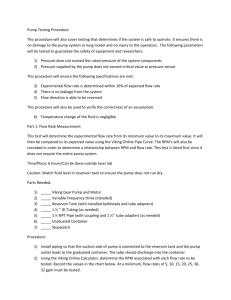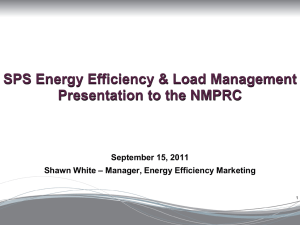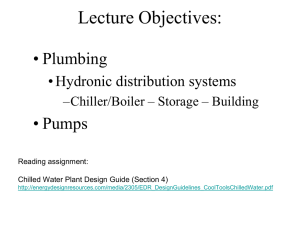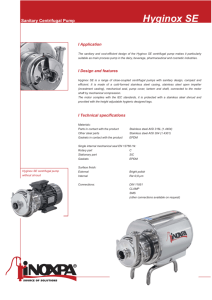Set9ans_12
advertisement
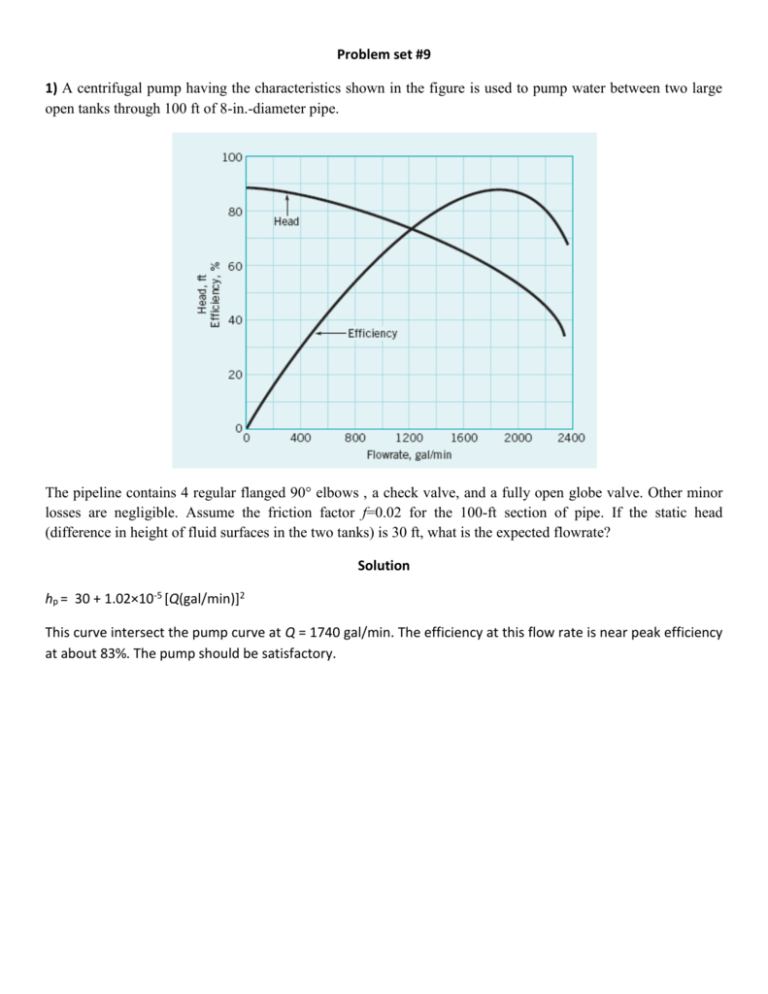
Problem set #9 1) A centrifugal pump having the characteristics shown in the figure is used to pump water between two large open tanks through 100 ft of 8-in.-diameter pipe. The pipeline contains 4 regular flanged 90° elbows , a check valve, and a fully open globe valve. Other minor losses are negligible. Assume the friction factor f=0.02 for the 100-ft section of pipe. If the static head (difference in height of fluid surfaces in the two tanks) is 30 ft, what is the expected flowrate? Solution hp = 30 + 1.02×10-5 [Q(gal/min)]2 This curve intersect the pump curve at Q = 1740 gal/min. The efficiency at this flow rate is near peak efficiency at about 83%. The pump should be satisfactory. 2) In a chemical processing plant a liquid is pumped from an open tank, through a 0.1-m-diameter vertical pipe, and into another open tank as shown in fig.a (assume elevation difference h = 30 m instead h = 30 m as shown). A valve is located in the pipe, and the minor loss coefficient for the valve as a function of the valve setting is shown in fig. b. The pump head capacity relationship is given by the equation h a = 52.0 - 1.01x103 Q2 with ha in meters when Q is in m3/s . Assume the friction factor f = 0.02 for the pipe, and all minor losses, except for the valve, are negligible. The fluid levels in the two tanks can be assumed to remain constant. (a) Determine the flowrate with the valve wide open. (b) Determine the required valve setting (percent open) to reduce the flowrate by 50%. Solution hp = 33 + 5.78×103 [Q(m3/s)]2 Since the pump equation is ha = 52.0 - 1.01x103 Q2 hp = 33 + 5.78×103 Q2 = 52.0 - 1.01x103 Q2 Q = 0.0529 m3/s (b) Determine the required valve setting (percent open) to reduce the flowrate by 50%. ha = 52.0 - 1.01x103 Q2 = 52.0 - 1.01x103 (0.0529/2 )2 = 50.6 m hp = 50.6 m = 33 m + (KL + 6)(826)(0.0529/2)2 KL = 24.3 From Figure 12.29b the valve should be 13% open to obtain this value. 3) A centrifugal pump having an impeller diameter of 1 m is to be constructed so that it will supply a head rise of 200 m at a flowrate of 4.1 m3/s of water when operating at a speed of 1200 rpm. To study the characteristics of this pump, a 1/5 scale, geometrically similar model operated at the same speed is to be tested in the laboratory. Determine (a) the required model discharge and (b) head rise. Assume that both model and prototype operate with the same efficiency (and therefore the same flow coefficient). Solution For similarity, the model pump must operate at the same flow coefficient so that Q Q D3 = D 3 p m m Dm Qm = p D p 3 Qp Qm = (1)(1/5)3(4.1) = 0.0328 m3 g p m gha gha We also have 2 D 2 = 2 D 2 ha,m = g p m m p ha,m = (1)(1)2(1/5)2(200) = 8.0 m 2 Dm Dp 2 ha,p 4) A centrifugal pump has the performance characteristics of the pump with the 6-in.-diameter impeller described in the Figure. Note that the pump in this figure is operating at 3500 rpm. What is the expected head gained if the speed of this pump is reduced to 2800 rpm while operating at peak efficiency? Solution From the figure, for the 6-in diameter impeller operating at 3500 rpm, Q = 170 gpm and hL = 230 ft. If the pump is still operated at peak efficiency with the speed reduced to 2800 rpm then Q1 Q2 = 1 2 Q2 = 2 1 Q1 = (2,800/3,500)(170) = 136 gpm ha1 12 We also have = ha2 = 2 ha 2 2 2 1 2 ha1 ha2 = (2,800/3,500)2(230) = 147 ft 5) A centrifugal pump provides a flowrate of 500 gpm when operating at 1750 rpm against a 200-ft head. Determine (a) the pump's flowrate and (b) developed head if the pump speed is increased to 3500 rpm. Solution Q1 Q2 = 1 2 Q2 = 2 1 Q1 = (3,500/1,750)(500) = 100 gpm ha1 12 We also have = ha2 = 2 ha 2 2 2 1 2 ha1 ha2 = (3,500/1,750)2(200) = 80 ft 6) In a certain application a pump is required to deliver 5000 gpm against a 300-ft head when operating at 1200 rpm. Find a specific speed Nsd of the pump and recommend an appropriate pump from the given figure. Solution Nsd = (rpm) Q( gpm) 1200 5000 = = 1180 ha ( ft )3 / 4 (300)3 / 4 From the above figure, at specific speed of 1180, a radial flow pump (centrifugal pump) would be recommended. 7) A hydraulic turbine operating at 180 rpm with a head of 100 feet develops 20,000 horsepower. Estimate the power if the same turbine were to operate under a head of 50 ft. Solution Head coefficient remains constant: gha gha 100 50 = 2 D 2 2 D 2 1802 = 2 1 2 2 2 = 127 rpm Power coefficient is the same since D1 = D2 and g1 = g2 Wshaft Wshaft 20,000 Wshaft ,2 = = 3 3 3 D5 3 D5 100 127 1 2 since D1 = D2 and g1 = g2 Wshaft ,2 = 41,000 hp 8) Water for a Pelton wheel turbine flows from the headwater and through the penstock as shown in the given Figure. The effective friction factor for the penstock, control valves, and the like is 0.032 and the diameter of the jet is 0.20 m. Determine the maximum power output. Solution Maximum W shaft = 23,200 kW 12.70) Turbines are to be designed to develop 30000 horsepower while operating under a head of 70 ft and an angular velocity of 60 rpm. Estimate the flowrate needed. Solution N’sd = (rpm) Wshaft (hp) 60 30,000 = = 1180 ht ( ft )5 / 4 (70)5 / 4 Wshaft = Qht Q = Wshaft /ht = (30,000×550)/(62.4×70) Q = 378 ft3/s
